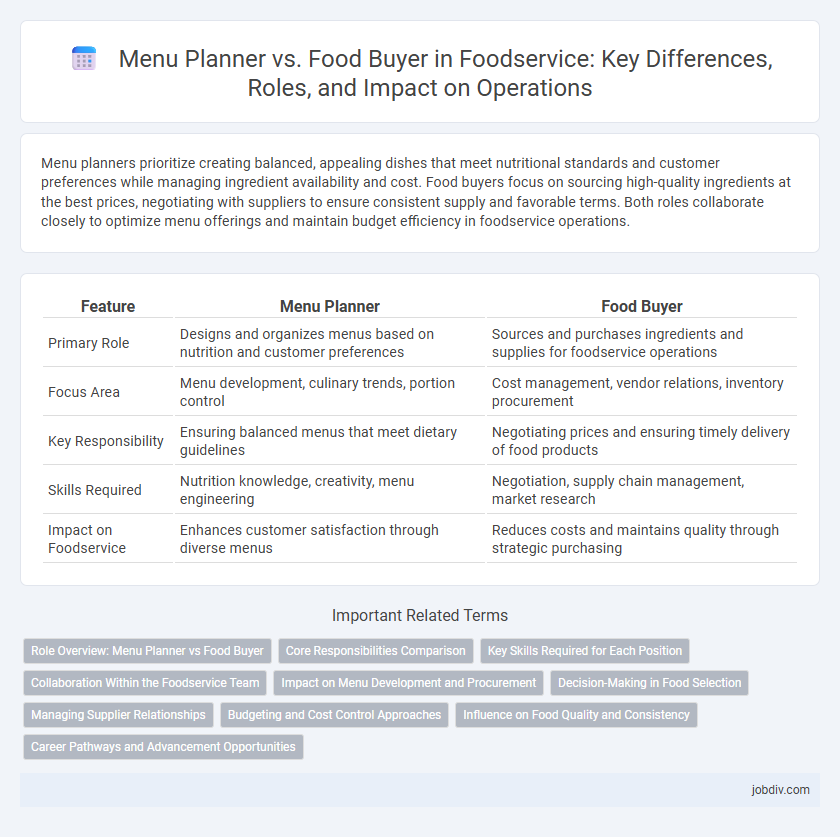Menu planners prioritize creating balanced, appealing dishes that meet nutritional standards and customer preferences while managing ingredient availability and cost. Food buyers focus on sourcing high-quality ingredients at the best prices, negotiating with suppliers to ensure consistent supply and favorable terms. Both roles collaborate closely to optimize menu offerings and maintain budget efficiency in foodservice operations.
Table of Comparison
| Feature | Menu Planner | Food Buyer |
|---|---|---|
| Primary Role | Designs and organizes menus based on nutrition and customer preferences | Sources and purchases ingredients and supplies for foodservice operations |
| Focus Area | Menu development, culinary trends, portion control | Cost management, vendor relations, inventory procurement |
| Key Responsibility | Ensuring balanced menus that meet dietary guidelines | Negotiating prices and ensuring timely delivery of food products |
| Skills Required | Nutrition knowledge, creativity, menu engineering | Negotiation, supply chain management, market research |
| Impact on Foodservice | Enhances customer satisfaction through diverse menus | Reduces costs and maintains quality through strategic purchasing |
Role Overview: Menu Planner vs Food Buyer
Menu planners design and organize menus that balance nutritional value, cost, and customer preferences to optimize dining experiences. Food buyers procure high-quality ingredients by negotiating with suppliers and managing inventory to ensure cost-efficiency and freshness. Both roles collaborate closely to align menu creation with supply chain management, enhancing operational efficiency in foodservice establishments.
Core Responsibilities Comparison
Menu planners analyze customer preferences and nutritional guidelines to design balanced, appealing menus that optimize ingredient use and cost efficiency. Food buyers specialize in sourcing high-quality ingredients at competitive prices, managing supplier relationships, and ensuring timely delivery to maintain inventory levels. Both roles collaborate closely to align menu offerings with budget constraints and operational needs in foodservice management.
Key Skills Required for Each Position
Menu planners require strong culinary knowledge, creativity in recipe development, and an understanding of nutritional guidelines to design appealing and balanced menus. Food buyers need expertise in market trends, inventory management, negotiation skills, and cost analysis to procure quality ingredients at the best prices. Both roles demand excellent communication and organizational abilities to coordinate effectively with kitchen staff and suppliers.
Collaboration Within the Foodservice Team
Menu planners and food buyers collaborate closely within the foodservice team to ensure menu offerings align with budgetary constraints and ingredient availability. Effective communication between menu planners, who design dishes based on customer preferences and nutritional guidelines, and food buyers, who source quality ingredients at optimal prices, enhances operational efficiency and reduces waste. This collaboration drives cohesive supply chain management, resulting in consistent menu execution and improved customer satisfaction.
Impact on Menu Development and Procurement
Menu planners drive menu development by analyzing customer preferences, nutritional requirements, and seasonal availability to create balanced, appealing offerings that align with brand identity and cost goals. Food buyers impact procurement by negotiating with suppliers, ensuring quality, and managing inventory to secure the best prices and timely delivery of ingredients critical for menu execution. The collaboration between menu planners and food buyers enhances operational efficiency, minimizing waste and optimizing food cost control throughout the foodservice supply chain.
Decision-Making in Food Selection
Menu planners strategically design dishes based on customer preferences, nutritional balance, and seasonal availability to optimize satisfaction and operational efficiency. Food buyers concentrate on sourcing quality ingredients at competitive prices while ensuring supplier reliability and compliance with food safety standards. Effective decision-making in food selection demands close collaboration between menu planners and food buyers to align culinary vision with procurement realities.
Managing Supplier Relationships
Menu planners collaborate closely with food buyers to ensure supplier relationships align with menu design and ingredient quality standards. Food buyers negotiate contracts, monitor vendor performance, and secure the best prices while maintaining consistent supply chains. Effective supplier management enhances menu reliability, cost control, and ingredient freshness in foodservice operations.
Budgeting and Cost Control Approaches
Menu planners develop cost-effective recipes by analyzing ingredient prices and portion sizes to maximize profit margins while maintaining quality. Food buyers focus on negotiating purchase agreements and selecting suppliers to secure the best prices and ensure consistent supply within budget constraints. Both roles collaborate to align menu offerings with financial goals, employing inventory management and price forecasting to optimize cost control.
Influence on Food Quality and Consistency
Menu planners directly influence food quality by selecting ingredients and dishes that meet nutritional standards and customer preferences, ensuring consistent dining experiences. Food buyers impact consistency through sourcing reliable suppliers and negotiating for high-quality products that align with menu requirements. Collaboration between menu planners and food buyers is essential for maintaining overall food quality and consistency in foodservice operations.
Career Pathways and Advancement Opportunities
Menu planners develop culinary concepts and design meal options, laying the foundation for creative leadership roles in foodservice management or hospitality direction. Food buyers leverage market analysis and supplier negotiations, positioning themselves for advancement into procurement management or supply chain leadership. Both career pathways offer distinct advancement opportunities that align with strategic operational roles within the foodservice industry.
Menu Planner vs Food Buyer Infographic

 jobdiv.com
jobdiv.com